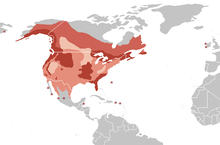Bald eagle
| Bald eagle | |
|---|---|
 |
|
| Adult bald eagle on the Alsek River | |
| Scientific classification | |
| Kingdom: | Animalia |
| Phylum: | Chordata |
| Class: | Aves |
| Order: | Accipitriformes |
| Family: | Accipitridae |
| Genus: | Haliaeetus |
| Species: | H. leucocephalus |
| Binomial name | |
|
Haliaeetus leucocephalus (Linnaeus, 1766) |
|
| Subspecies | |
|
H. l. leucocephalus – Southern bald eagle |
|
 |
|
| Bald eagle range
Breeding resident
Breeding summer visitor
Winter visitor
On migration only
Star: accidental records
|
|
| Synonyms | |
|
Falco leucocephalus Linnaeus, 1766 |
|
H. l. leucocephalus – Southern bald eagle
H. l. washingtoniensis – Northern bald eagle
Falco leucocephalus Linnaeus, 1766
The bald eagle (Haliaeetus leucocephalus, from Greek hali "sea", aiētos "eagle", leuco "white", cephalos "head") is a bird of prey found in North America. A sea eagle, it has two known subspecies and forms a species pair with the white-tailed eagle (Haliaeetus albicilla). Its range includes most of Canada and Alaska, all of the contiguous United States, and northern Mexico. It is found near large bodies of open water with an abundant food supply and old-growth trees for nesting.
The bald eagle is an opportunistic feeder which subsists mainly on fish, which it swoops down and snatches from the water with its talons. It builds the largest nest of any North American bird and the largest tree nests ever recorded for any animal species, up to 4 m (13 ft) deep, 2.5 m (8.2 ft) wide, and 1 metric ton (1.1 short tons) in weight.Sexual maturity is attained at the age of four to five years.
Bald eagles are not actually bald; the name derives from an older meaning of the word, "white headed". The adult is mainly brown with a white head and tail. The sexes are identical in plumage, but females are about 25 percent larger than males. The beak is large and hooked. The plumage of the immature is brown.
The bald eagle is both the national bird and national animal of the United States of America. The bald eagle appears on its seal. In the late 20th century it was on the brink of extirpation in the contiguous United States. Populations have since recovered and the species was removed from the U.S. government's list of endangered species on July 12, 1995 and transferred to the list of threatened species. It was removed from the List of Endangered and Threatened Wildlife in the Lower 48 States on June 28, 2007.
...
Wikipedia

